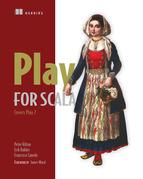Part 2. Core functionality
Part 2 teaches you how to use Play’s standard features, organized by common web development concepts, and it contains material that every developer should be familiar with.
Chapter 3 dives into Play’s internal architecture. We show why Play works well with the web instead of against it and how control flows through a Play application. Furthermore, we show how the model, views, and controllers work together and how to modularize an application.
Chapter 4 explains, in detail, how controllers work. They form the boundary between HTTP and Play. You’ll learn how to map URLs to actions in your code and how to deal with URL and query-string parameters in a type-safe way. We show how to use Play forms to validate and retrieve user input from HTML forms and how to return an HTTP response to the client.
Chapter 5 shows how a persistence layer fits into a Play application. Anorm is a data access layer for SQL databases that comes with Play, and it works with plain SQL. We also show how to use Squeryl, a Scala domain-specific language for querying databases.
In chapter 6 we show how Play’s template engine works. We explain the syntax and how Scala is used to make templates type-safe. We’ll show you how to build reusable template blocks and how to compose these blocks into larger templates.
Chapter 7 explains Play forms in detail. Forms allow you to validate form data and map form data to Scala objects. They also help when populating HTML forms with existing data.
